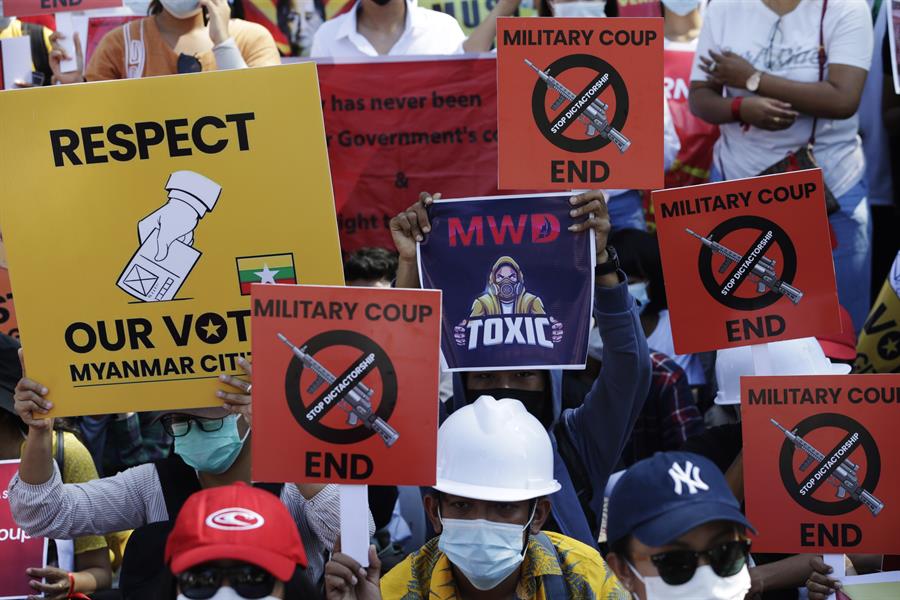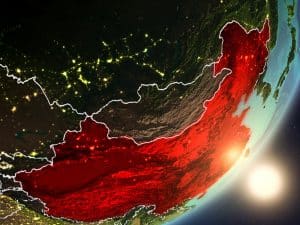The military’s motivation for staging a coup d’état in Myanmar (formerly Burma) remains unclear. There is no doubt, though, that the coup is reactionary. Moreover, as has become clear since the coup began on February 1, it has triggered a strong popular mobilization in which the working class plays a prominent role.
As Andrew Tillett-Saks, a labor organizer in Yangon (Rangoon), told Nikkei Asia, “The sight of industrial workers, largely young, women garment workers, seems to have deeply inspired the general public, broken down some of the fear and catalyzed the massive protests and general strike we are seeing now.”
The working class as a social force thus has a strong presence in the resistance to Myanmar’s military. How did this come about? What processes of struggle and organization has this young working class been developing? And finally, most important, will the working class be able to impose its own program against the military and the liberal bourgeois political forces that have ruled the country in recent years — and maintain the confidence of the popular movement?
A New, Super-Exploited Working Class
Myanmar is one of the fastest growing countries in Southeast Asia in the last decade. This follows the “democratic opening” initiated in 2011, which allowed the introduction of Western capital as well as Chinese investors. This has allowed the development of mainly light industrial sectors — a breath of fresh air for a totally underdeveloped economy in one of the world’s poorest countries. These investments have had social (and political) consequences, of course, including the formation of a “new” young and very large (by the standards of this small country of 50 million inhabitants) working class that has become, as we see today, potentially powerful.
Stephen Campbell, an anthropologist and specialist on the working class in Myanmar and Thailand, wrote about the process of formation of this working class:
The working-class population in Yangon’s industrial zones comprises mostly former villagers pushed out of rural areas due to unmanageable debt, the infrastructural devastation of 2008’s Cyclone Nargis, and outright theft of their land by military and private business interests. As real estate speculation and elitist urban development over the past ten years drove up the cost of housing, hundreds of thousands of migrants arriving in the city were priced out of formal accommodation and turned instead to cheaper squatter housing on the city’s outskirts. Many of these new urban residents sought employment in food and other processing factories producing for the domestic market, or at garment factories producing for export. By 2018, over a million workers — mostly young women, including many squatters — were employed in garment, textile, footwear, and accessories factories in Myanmar — mostly around Yangon. In this context, workers at factories and workplaces across Yangon’s industrial zones have over the past decade organized collectively, formed unions, and gone on strike in impressive struggles against employer intransigence and outright violence. Such struggles pre-date the country’s so-called democratic transition that began in 2011, which was also the year new labor legalization granted workers a legal right to form unions. So, while the new labor law cannot be credited with empowering workers, it did grant them greater legal space in which to organize.
This proletarianization of the rural population, however, has not been accompanied by a significant improvement in living conditions and income. Inflation and low wages have kept the working class in a very precarious situation, forcing some workers to look for jobs in richer neighboring countries such as Singapore, Malaysia, and Thailand. In fact, one of the main “advantages” the government and military has touted to attract investment from multinationals, especially in the garment sector, has been the very low wages: in Myanmar, the monthly minimum wage is $63 (about $3 a day), while wages in neighboring (and competing) countries such as Vietnam and Cambodia range from $90 to $145 a month.
Compounding these miserable wages are systemic worker harassment, judicial persecution of trade unionists, and police repression. The legal frameworks, even those established by the new “democratic” powers, benefit the employers. In other words, the conditions are very favorable for capital at the expense of workers’ rights.
Fighting for Better Working Conditions and Dignity
However, if the local and international capitalists and the military thought that the workers, especially women, were going to remain passive in the face of this exploitation, they were very wrong. In fact, recently the Myanmar working class led resistance struggles to improve working conditions and against the abuses of the bosses.
As Campbell explains in an interview,
Since around 2009, there have been recurring strikes, mostly in the industrial zones around Yangon. Factory workers have repeatedly expressed indignation about wage theft, forced overtime, managerial harassment, the firing of worker organizers and poor working conditions. In addition, inflation continues to raise the cost of living in Myanmar; this has eroded the value of workers’ wages and forced many workers to take on large debts to cover basic living expenses. These factors have all motivated persistent worker unrest in Myanmar, including the recent spate of labor protest.
This situation has been exacerbated by the Covid-19 pandemic, which has led to a drastic drop in orders, especially for the garment industry, has caused some 60,000 workers to lose their jobs, and has closed hundreds of factories since April 2020. In addition, the government and the bosses have used the coronavirus-related health measures to repress and fire trade unionists and the most active workers. This gave rise to a wave of labor struggles that, in some cases, succeeded in curbing the employers’ abuses.
Thus, this young generation of workers is forced to fight to survive within a framework of super-exploitation. Their struggle is literally one for survival, to wrest from the bosses — who can count on the help of the government and repressive forces — their very right to live. It is thus a struggle for workers’ dignity, which gives their demands a very “radical” character and elevates their moral authority. This is a young workers’ movement that, after decades of brutal repression and being in hiding, has lifted its head to resist the multinationals, the military, and the bosses’ henchmen. This resistance is quite the model, one that deserves the respect of the international working class.
A Process of Union Organizing
This entire process of workers’ struggles is not simply the result of some kind of spontaneous resistance. It is also the result of the trade union organization Myanmar’s working class has been able to build in a very short time. Myanmar workers have suffered brutal repression by the military since the coup in 1962. Despite brief periods of “liberalization” in the country, union organizing was banned until 2011. Labor activists were condemned to going underground or into exile. But from 2011 on, with the so-called democratization of the country, new laws allowed workers to maneuver a bit and begin to create union organizations at the level of individual factories, companies, and even confederations. Through this union organizing, workers waged various struggles and strikes for their rights.
It is easy to understand why countries such as China, whose “model” serves as an inspiration to Myanmar’s capitalist class, are so determined to control the independent union organization of the workers — a situation that of course also benefits the Western multinationals. This is why the government and the bosses try to corrupt trade unions to be subservient to them, or even create their own such organizations.
For their part, international organizations such as the International Labour Organization (ILO) and the big Western trade union confederations try to “channel” the radicalism of the Myanmar workers, pushing them to adopt strategies of conciliation with the employers and the state while favoring the emergence of trade union bureaucracies. An article in Open Democracy deals extensively with the trade union issue from this conciliatory perspective. The Confederation of Trade Unions of Myanmar (CTUM) “and its members don’t encourage strikes. … Unions aim to establish themselves as a credible actor in the emerging industrial relations landscape in Myanmar, which is difficult if they are too confrontational. In addition, international organizations and donors put friendly pressure on them to solve disputes through dialogue and arbitration rather than through open conflict.”
The same international organizations are working with the political authorities to put in place legislation to limit the use of countermeasures such as strikes. As Stephen Campbell explains,
The quasi-civilian government of U Thein Sein, which took power in 2011, introduced new legislation drafted with support from the ILO, legalizing trade-union formation (in October 2011) and formalizing collective bargaining (in March 2012). The new laws aimed to curb strikes by providing institutional channels for workers to pursue redress of employment grievances. In practice, however, many workers found these new institutional channels inadequate and so took the opportunity provided by the new legal coverage to increase strikes. As a result, in 2012, there was another wave of strikes in the Hlaingtharyar, Shwepyithar, and Hmawbi industrial zones around Yangon.
In other words, in this process of union organizing, workers must also fight against attempts to divert them into channels of “dialogue” and negotiation with management and the state, all within the framework of completely pro-employer institutions.
A Struggle for a Return to Liberal Democracy?
It is in this context that the reaction of the workers to the coup should be understood. Despite all these pro-boss laws and policies, the working class has taken advantage of the few democratic freedoms the 2011 “opening” allowed to strengthen its organization in the factories and in companies. For many workers, the coup is synonymous with a setback, a loss of their gains, however limited, especially in terms of independent organization. As one union activist cited by Campbell stated:
Now that the military has taken power, I’m worried the situation will go back to the way it was before [under military rule] and that the workers won’t have any rights anymore. Also, we were told that the [legal minimum] wage was going to be increased in the coming months. The young workers were hoping for that. But now we don’t expect that there’ll be an increase. It’ll be as though we’ve lost our rights. And with the military taking power, it’ll be like it was before, and employers will oppress the workers and reduce their wages.
From this point of view, it is not surprising that it has been the workers at the forefront of resistance against the coup. For them, it is not a question of fighting for abstract freedom, but of fighting for survival and against an even greater threat of oppression by the bosses and the military. The experience of strikes, partial struggles, and organization has undoubtedly enabled the working class to arrive better prepared and able to play a very active role in the present situation.
However, as far as the political objectives of the mobilization are concerned, the working class is soon very likely to find itself at a dead end if it limits itself to a simple return to liberal democracy under a new government of Aung San Suu Kyi’s party. Her program is thoroughly capitalist, pro-business, and pro-imperialist. Her government has allowed the bosses to pay workers a pittance and to be humiliated in factories and enterprises in the countryside. Her government sent the security forces to repress strikes and arrest trade unionists under any pretext, including the health situation. And Aung San Suu Kyi has shown quite well that she knows how to reconcile with the power of the military, not struggle against it. There is a reason she has the support of the United States and a large number of the imperialist countries, since she has been the guarantor of the business of the multinationals and the super-exploitation of Myanmar’s workers.
If the working class, which is putting its collective bodies on the line in the resistance, fails to develop a policy of class independence, the movement will continue to be led — as it has thus far — by the bourgeois, pro-imperialist policy of Aung San Suu Kyi. That is the great contradiction in the movement today.
The challenge is to establish the terms of an independent mobilization of the working class, the poor peasants, and the poor against the coup, but also against the various capitalist political alternatives. This struggle is also being waged within the workers’ movement itself. Again Campbell explains it this way:
Some trade union federations in Myanmar remain formally independent from political parties, but several upper-level union officials are aligned with the ruling [Aung San Suu Kyi’s] National League for Democracy. The Confederation of Trade Unions of Myanmar, for example, was previously an exiled political organization based in Thailand, where its General Secretary, U Maung Maung, also served as General Secretary of the NLD-aligned National Council of the Union of Burma.
The political independence of the workers and of all Myanmar’s exploited and oppressed have the possibility of overthrowing the entire system that crushes them, that despises their political and economic rights, and that is complicit in crimes against humanity directed at ethnic minorities. But this implies going beyond trade union organization toward the creation of a political organization of the workers themselves that offers an alternative to what is an enormous social movement that is on the move.
First published in Spanish on February 13 in La Izquierda Diario.
Translation by Scott Cooper











